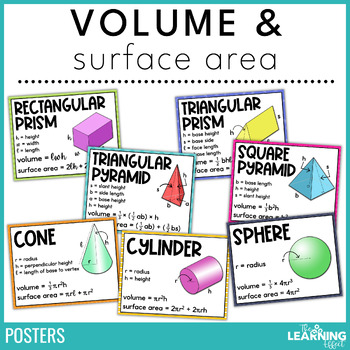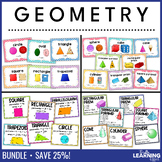Volume & Surface Area Formula Posters | Math Geometry Vocabulary Anchor Charts
- PDF
What educators are saying
Also included in
- Help your students learn all about geometry with these colorful posters. This bundle includes posters for 2D shapes, 3D shapes, perimeter, area, circumference, volume, and surface area. There is also a FREE 3D Shape Nets printable included.Save 25% by purchasing five geometry resources in this discoPrice $11.75Original Price $15.75Save $4.00
Description
Learning the formulas for volume and surface area of 3D figures can be challenging when learning about more than one figure. These formula posters will help your students learn this math standard in no time!
⭐ BUNDLE & SAVE ⭐
Save 25% by purchasing this resource in a bundle with three other geometry resources
THIS RESOURCE INCLUDES
- 25 brightly colored page-size posters:
- Bulletin board header
- Volume
- Surface area
- Full-pages with all formulas (split between 2 pages)
- Formula, net, real-life example, and definition for each shape (3 pages):
- Rectangular prism
- Triangular prism
- Triangular pyramid
- Square pyramid
- Cone
- Cylinder
- Sphere
- Black/white ink-saving version
- Student reference strips (print three per page)
INCLUDED FILE FORMAT
- PDF: This resource requires Adobe Reader (free software). The contents may not show correctly if using other PDF software.
PLEASE NOTE
⚠️ The PDF is NOT editable in any way, and you will not be able to manipulate the content inside.
Volume and Surface Area Resources
- Volume Game Show | 5th Grade
- Volume and Surface Area Game Show | 6th Grade
- Earth Day Math Activities Mystery Picture & Pixel Art BUNDLE | Print + Digital
CLICK HERE to follow The Learning Effect and be the first to know when NEW resources are added to my store!
New resources are always discounted for the first 48 hours.
CONNECT WITH ME
The Learning Effect Blog • Instagram • Facebook • Email Sign Up
Please ask ALL questions before purchasing.
© The Learning Effect, LLC | Tiffany Schmidt
All rights reserved by author.
Permission to copy for single classroom use only.
Please purchase additional licenses at a discounted rate for additional users.
Intended for classroom and personal use only.






